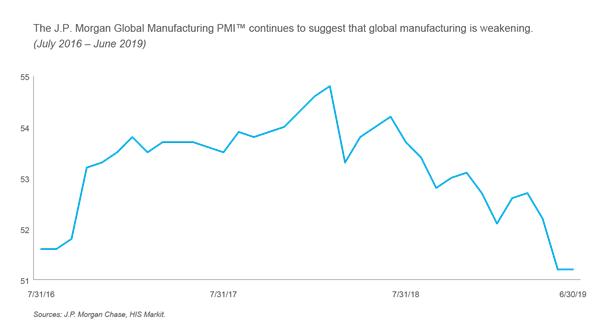Approaching midnight?
WASIF LATIF 16-Jul-2019

The bull market for U.S. stocks has been stampeding for more than 10 years now, and it may have further to run. In the first quarter, the S&P 500® Index delivered its best first quarter since 1998 with a total return of more than 13%. The second quarter saw more of the same as the market continued to climb more than 4% despite a few bouts of volatility, thanks to renewed fears that trade turmoil would damage the economy and future earnings. To put it all into perspective, the S&P 500’s total return since March 9, 2009, which is widely seen as the beginning of the current bull market, has exceeded 400%. That’s quite a climb. Domestic small caps, as measured by the Russell 2000® Index, have enjoyed similar fortunes.
For the moment, investors seem to be rejoicing over a continuing Goldilocks environment for stocks. The Federal Reserve has signaled an accommodative monetary policy, a sharp reversal from the rising interest rate fears of late last year. On top of that, inflation remains tepid, job growth continues unabated, and the consumer still seems to be spending freely.

Despite this constructive backdrop for equities, it’s important to understand why the Fed made its pivot from hawkish to neutral (or dovish) policy. Among other reasons, it was a tacit acknowledgment that risks to global growth were mounting . And given that the current run in stocks is more than a decade old, one can only wonder if the markets have priced-in most of the good news. Are investors now over-eager and setup for disappointment?
No one knows with any certainty if we are at or near the top. Nevertheless, the current environment seems reminiscent of the late stages of an economic cycle, and a number of vulnerabilities are becoming more evident with every day. For example, justifying valuations already above the historic average is becoming more difficult. The benefits of the 2017 tax cut are tapering, and earnings growth appears to be decelerating as labor and other costs (including those associated with tariffs) are rising.
So, while the market has continued making new highs, what’s particularly noteworthy to us has been an inversion of the yield curve and even the crimping effect of tightening monetary policy given the normalizing (i.e. aggressive shrinking) of the Fed’s balance sheet. Yes, there is room for some optimism with regard to the direction of short-term interest rates, but what will happen to equities if the Fed disappoints on the number and size of expected rate cuts this year?
Typically, falling interest rates coincide with weaker economic prospects, so robust stock performance to date this year may be an indication that markets are moving deeper into speculative territory. In fact, there appears to be a disconnect between the equity and bond markets, and that raises the distinct possibility that the returns for stocks may be short-lived. We experienced similar market dynamics at the turn of the millennium, and though there were other factors at play that story didn’t end well.
To be clear, we’re not calling for the same drawdown or turmoil that occurred between 2000 and 2002, but it’s important to remember that market momentum can turn abruptly. Near-term overcorrections are not uncommon, and rich valuations, shrinking earnings, and onerous corporate debt loads are among the risks worth monitoring.
Given the current environment and potential that we are in the latest stages of the cycle, it may be helpful to consider what strategies historically performed well relative to the market when the lurking risks are poised to come to the forefront. These might include portfolios that:
- Spread risk equally across all constituents and are less concentrated than those based on market capitalization weighted indexes
- Allocate to stocks exhibiting lower volatility metrics than the overall market
- Focus on companies that pay a meaningful dividend
Nobody knows where the market is going tomorrow. That’s why investors should avoid taking the ostrich approach and be blind to the mounting risks. Rather, consider incorporating strategies with characteristics that tend to show some resilience in the late stages of a cycle. This might allow investors to participate if the bulls keep running, while also being prepared should end of the cycle come quickly.




